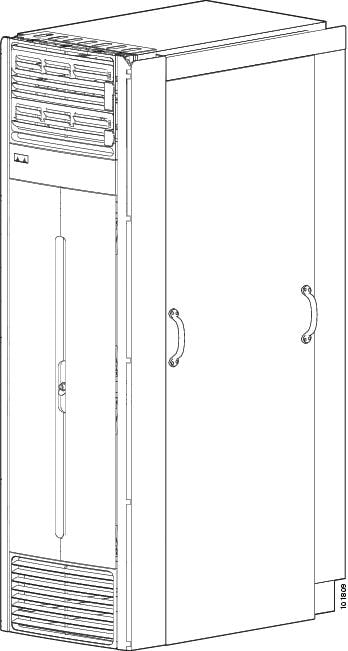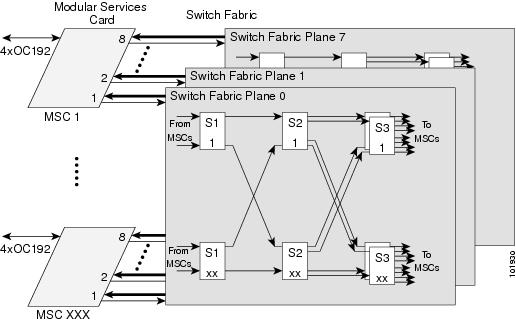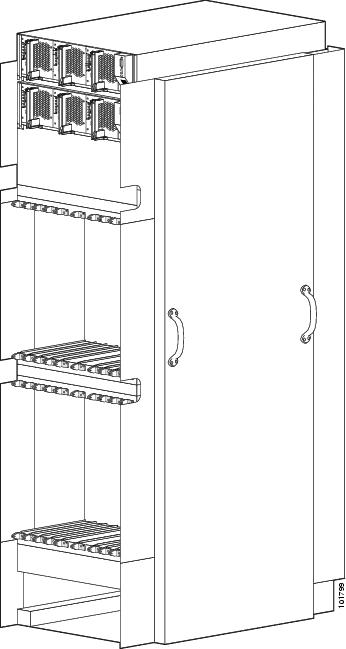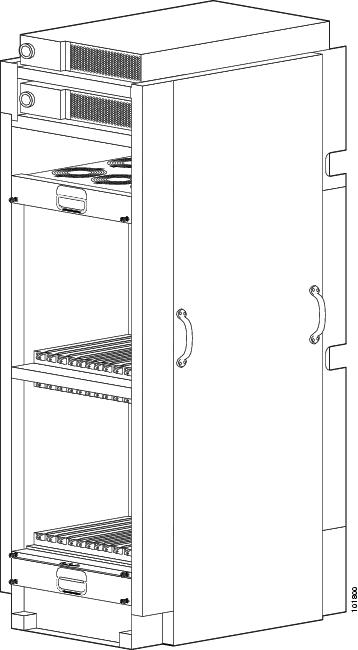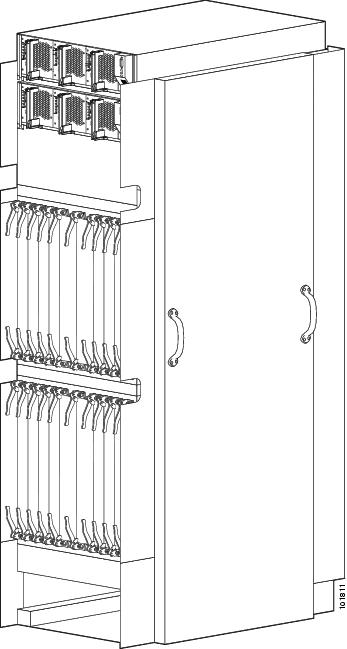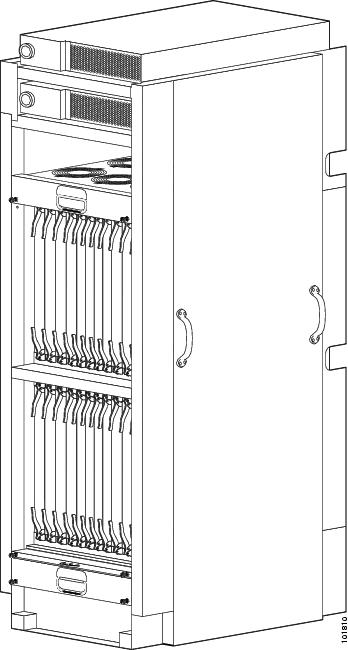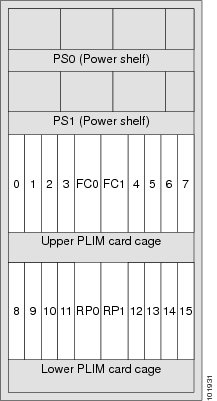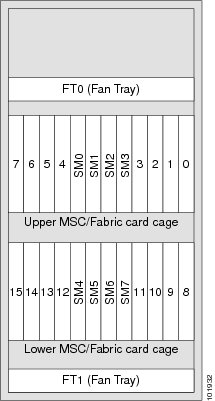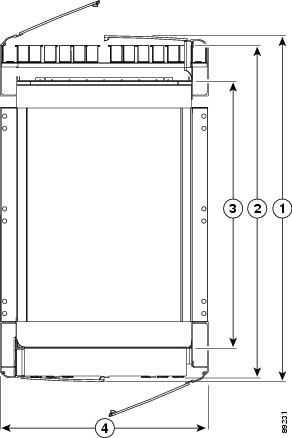

-
Cisco CRS-1 Carrier Routing System 16-Slot Line Card Chassis System Description
-
Preface
-
Cisco CRS-1 Carrier Routing System
-
Chassis Power System
-
Chassis Cooling System
-
Switch Fabric
-
Modular Services Cards (MSCs) and Physical Layer Interface Modules (PLIMs)
-
Route Processor
-
Cable Management, System Interconnection, and BITS Support
-
Control Plane
-
Cisco CRS-1 Carrier Routing System 16-Slot Line Card Chassis Specifications
-
Index
-
Table Of Contents
Cisco CRS-1 Carrier Routing System
Cisco CRS-1 Routing System Overview
Cisco CRS-1 Carrier Routing System Architecture
Main Features of the Cisco CRS-1 Carrier Routing System
Line Card Chassis Slot Numbers
Line Card Chassis Cable Management
Line Card Chassis Exterior Components
Cisco CRS-1 Carrier Routing System
This chapter provides an overview of the Cisco CRS-1 Carrier Routing System and the basic system configuration. It contains the following sections:
•
Cisco CRS-1 Routing System Overview
•
Cisco CRS-1 Carrier Routing System Architecture
•
Main Features of the Cisco CRS-1 Carrier Routing System
Cisco CRS-1 Routing System Overview
The Cisco CRS-1 Carrier Routing System is a highly scalable routing platform designed for efficient service provider point of presence (POP) evolution as the IP network grows into a multiservices network.
The Cisco CRS-1 16-slot line card chassis is a mechanical enclosure that contains modular services cards (MSCs) and their associated physical layer interface modules (PLIMs), switch fabric cards, and route processor (RP) cards. The chassis is bolted to the facility floor and does not require an external rack. The chassis also contains its own power and cooling systems. See the "Line Card Chassis Overview" section for more information about the chassis.
Figure 1-1 shows a Cisco CRS-1 16-slot line card chassis (with external cosmetics installed).
Figure 1-1 Cisco CRS-1 16-Slot Line Card Chassis
Cisco CRS-1 Carrier Routing System Architecture
Every Cisco CRS-1 16-slot line card chassis has 16 modular service card (MSC) slots, each with a capacity of 40 gigabits per second (Gbps) ingress and 40 Gbps egress, for a total routing capacity per chassis of 1280 Gbps or 1.2 terabits per second (Tbps). (A terabit is 1 x 1012 bits or 1000 gigabits.)
The routing system is built around a scalable, distributed three-stage Benes switch fabric and a variety of data interfaces. The data interfaces are contained on PLIMs that mate with an associated MSC through the chassis midplane. The switch fabric cross-connects MSCs to each other. Figure 1-2 is a simple diagram of the basic Cisco CRS-1 routing system architecture.
Figure 1-2 Simple Cisco CRS-1 Routing System Architecture
Figure 1-2 illustrates the following concepts, which are common to all Cisco CRS-1 routing systems:
•
Packet data enters the MSC through physical data interfaces located on the associated PLIM. In Figure 1-2, these physical interfaces are represented by four OC-192 interfaces.
•
Data is routed through the MSC, a Layer 3 forwarding engine, to the three-stage Benes switch fabric. Each MSC and associated PLIM have Layer 1 through Layer 3 functionality, and each MSC delivers line-rate performance (40 Gbps aggregate bandwidth). See Chapter 5, "Modular Services Cards and Physical Layer Interface Modules," for more information.
•
The three-stage Benes switch fabric cross-connects the MSCs in the routing system. The switch fabric is partitioned into eight planes (plane 0 to plane 7) and is implemented by several components (see Figure 1-2). See Chapter 4, "Switch Fabric," for more information.
Main Features of the Cisco CRS-1 Carrier Routing System
The main features of all Cisco CRS-1 routing systems include:
•
A highly scalable router that provides a routing capacity between 1.2 and 2.4 Tbps and future scaling to 92 Tbps.
•
A wide range of interface speeds and types (such as OC-768, OC-192, OC-48, and 10-GE), and featuring a programmable MSC forwarding engine that provides full-featured forwarding at line-rate speeds.
•
Redundancy and reliability features to allow nonstop operation, with no single points of failure in hardware or software. The Cisco CRS-1 can be upgraded or serviced at any time while it is running.
•
Partitioning into logical routers. A logical router is a set of MSCs and route processors (RPs) that form a complete router. More specifically, each logical router contains its own instances of dynamic routing, IP stack, system database (SysDB), interface manager, event notification system, and so on. In this initial release, the single-shelf and multishelf systems are configured as a single logical router.
Line Card Chassis Overview
The Cisco CRS-1 16-slot line card chassis is the mechanical enclosure that contains the system components. The line card chassis is secured to the floor and has a locking front and optional rear doors. The line card chassis is a complete rack enclosed in a cabinet. A single-shelf (standalone) system consists of a single line card chassis only. A multishelf system consists of two line card chassis connected to a single fabric card chassis.
This section contains the following subsections:
•
Line Card Chassis Slot Numbers
•
Line Card Chassis Cable Management
•
Line Card Chassis Exterior Components
Line Card Chassis Components
Following is a list of the main components of a Cisco CRS-1 16-slot line card chassis. Most of the components are field-replaceable units (FRUs), which means they can be replaced by customers in the field.
•
As many as 16 modular services card (MSCs) and associated physical layer interface modules (PLIMs). An MSC and a PLIM are an associated pair of cards that mate through the chassis midplane. The MSC provides the forwarding engine for Layer 3 routing of user data, and the PLIM provides the physical interface and connectors for the user data. For more information, see Chapter 5, "Modular Services Cards and Physical Layer Interface Modules."
An MSC exists, but it can be associated with several different PLIMs, which provide different interface speeds and technologies. The available PLIMs are:
–
1-port OC-768c/STM-256c Packet-over-SONET (PoS); available with short-reach (SR) optics.
–
4-port OC-192c/STM-64c POS/DPT; available with long-reach (LR), intermediate-reach (IR), short-reach (SR), and very-short-reach (VSR) optics.
–
OC-48c/STM-16c POS/DPT, configurable with 1 to 16 ports; available with long-reach (LR) and short-reach (SR) optics. This PLIM supports pluggable optics.
–
10-Gigabit Ethernet (GE); available in long-reach (LR) optics. This PLIM supports pluggable optics and can be configured with 1 to 8 ports.
•
A chassis midplane that connects MSCs to their associated PLIMs. The midplane allows an MSC to be removed from the chassis without having to disconnect the cables that are attached to the associated PLIM. The midplane distributes power, connects the MSCs to the switch fabric cards, and provides control plane interconnections. The midplane is not field replaceable by the customer.
•
Two route processor cards (RPs) that perform route processing and supply the intelligence of the system by functioning as the line card chassis system controller. Only one RP is active at a time. The second RP acts as a standby RP, serving as a backup if the active RP fails.
The RP also monitors system alarms and controls the system fans. LEDS on the front panel indicate active alarm conditions. See Chapter 6, "Route Processor."
•
(Optional) One or more distributed route processor (DRP) cards, each with a corresponding PLIM. Each DRP and DRP PLIM function as an additional route processor (RP) in the system, providing additional route processing for the Cisco CRS-1 router. By off-loading processor-intensive tasks (such as BGP speakers and ISIS) from the RP to the DRP, you can improve system performance. See Chapter 6, "Route Processor."
•
Eight switch fabric cards that implement the three-stage Benes switch fabric for the system. The switch fabric receives user data from one MSC and PLIM pair and performs the switching necessary to route the data to the appropriate egress MSC and PLIM pair. See Chapter 4, "Switch Fabric." In a single-shelf system, S123 switch fabric cards provide all three stages of the switch fabric.
•
Two AC or two DC power shelves with three AC rectifiers or DC power entry modules (PEMs) in each power shelf. The power shelves and AC rectifiers or DC PEMs provide 13.2 kilowatts of redundant power for the chassis. See Chapter 2, "Cisco CRS-1 16-Slot Chassis Power System."
•
Two alarm modules that provide external alarm system connections. The modules are located in the AC or DC power shelves. See the "Alarm Module" section on page 2-16.
•
Two fan controller cards that vary the high-speed fans in the fan trays to adjust the airflow for ambient conditions. See the "16-Slot Line Card Chassis Fan Controller Card" section on page 3-6.
•
Upper and lower fan trays that push and pull air through the chassis. There is also a removable air filter located above the lower fan tray. See the "16-Slot Line Card Chassis Fan Tray" section on page 3-5.
The PLIM side of the chassis is considered the front of the chassis—this is where user data cables attach to the PLIMs and where cool air enters the chassis. The MSC side, which is where warm air is exhausted, is considered the rear of the chassis.
See Appendix A, "Cisco CRS-1 Carrier Routing System 16-Slot Line Card Chassis Specifications," for environmental and operating specifications for the line card chassis and its components.
The following figures show a front and rear view of a line card chassis.
Figure 1-3 Line Card Chassis Front View
Figure 1-4 CRS-1 16-Slot Line Card Chassis Rear View
Figure 1-5 is the front view of a line card chassis with cards installed.
Figure 1-5 CRS-1 16-Slot Line Card Chassis Front View With Cards Installed
Figure 1-6 is a rear view of the line card chassis with modular services cards installed.
Figure 1-6 CRS-1 16-Slot Line Card Chassis Rear View with Modular Services Cards Installed
Line Card Chassis Slot Numbers
This section describes the location and slot numbers for cards and modules that plug into the chassis. Figure 1-7 shows the slot numbers on the PLIM (front) side of the line card chassis.
Figure 1-7 Cisco CRS-1 16-Slot Line Card Chassis Front View Slot Numbers (PLIM Side)
As shown, the line card chassis numbers on the PLIM side of the chassis include:
•
Power shelf 0 (PS0) and associated power module slots A0, A1, A2; alarm module slot (AM0).
•
Power shelf 1 (PS1) and associated power module slots B0, B1, B2; alarm module slot (AM1).
•
Upper PLIM card cage with eight MSC slots (left to right, 0, 1, 2, 3...4, 5, 6, 7) and two double-width fan controller card slots, FC0 and FC1.
•
Lower PLIM card cage with eight MSC slots (left to right, 8, 9,10, 11...12, 13, 14, 15) and two double-width route processor card slots, RP0 and RP1.
Figure 1-8 shows the slot numbers on the MSC (rear) side of the line card chassis.
Figure 1-8 Cisco CRS-1 16-Slot Line Card Chassis Rear View Slot Numbers (MSC Side)
As shown, the slot numbers on the MSC side of the chassis include:
•
Top fan tray (FT0).
•
Upper MSC-switch fabric cage, eight line card slots (7, 6, 5, 4...3, 2, 1, 0) and four switch fabric card slots (SM0, SM1, SM2, and SM3).
•
Lower MSC-switch fabric cage, eight line card slots (15, 14, 13, 12...11, 10, 9, 8) and four switch fabric card slots (SM4, SM5, SM6, and SM7).
•
Lower fan tray (FT1).
The MSC slot numbers are reversed from the PLIM slot numbers on the other side of the chassis. Because an MSC mates with its associated PLIM through the midplane, MSC slot 0 is on the far right side of the chassis looking at it from the MSC (rear) side; PLIM slot 0 is on the far left side of the chassis looking at if from the PLIM (front) side. MSC slot 0 and PLIM slot 0 mate with one another through the midplane, and so do all the other MSC and PLIM slots (2 through 15).
Line Card Chassis Footprint
Figure 1-9 is a top view of the line card chassis footprint (with optional front and rear cosmetics installed).
Figure 1-9 Top View of CRS-1 16-Slot Line Card Chassis
40.236 in. (102.199 cm)
38.264 in. (97.191 cm)
32.766 in. (83.226 cm)
23.546 in. (59.807 cm)
The dimensions listed in the previous figure show the:
•
Depth of the line card chassis with the doors attached and closed, which is 40.236 in. (102.199 cm).
•
Depth of the front cable management to the rear cable management, excluding the doors, which is 38.264 in. (97.191 cm).
•
Distance from the front surface to the rear surface of the chassis, excluding cable management and the doors, which is 32.766 in. (83.226 cm).
•
Width of the chassis, which is 23.546 in. (59.807 cm).
Note
Because there is no external switch-fabric interconnection cabling on the single line card chassis system, the rear door is optional.
Line Card Chassis Cable Management
The Cisco CRS-1 16-slot line card chassis has cable-management features for both the PLIM and MSC sides of the chassis. The PLIM side of the chassis has horizontal cable-management trays above both card cages. These trays have a special telescoping feature that allows them to be extended when the chassis is upgraded with higher-density cards. This extension feature also helps in installing the cables in the chassis.
The MSC side of the chassis has a single non-telescoping cable-management tray above the lower card cage (in the middle of the chassis). In a single-shelf system, there are no external cables connected to the MSC side of the chassis. See the Cisco CRS-1 Carrier Routing System 16-Slot Line Card Chassis Installation Guide for detailed information about chassis cabling and cable management.
Line Card Chassis Exterior Components
The Cisco CRS-1 16-slot line card chassis also includes front and rear locking doors, bezels and side panels. The rear doors are optional in the stand-alone system. The cosmetic components are shipped in a separate package and must be installed on the Cisco CRS-1 16-slot line card chassis during system installation. Figure 1-10 shows the front of the Cisco CRS-1 16-slot line card chassis exterior components.
Figure 1-10 CRS-1 16-Slot Line Card Chassis Front Exterior Components

